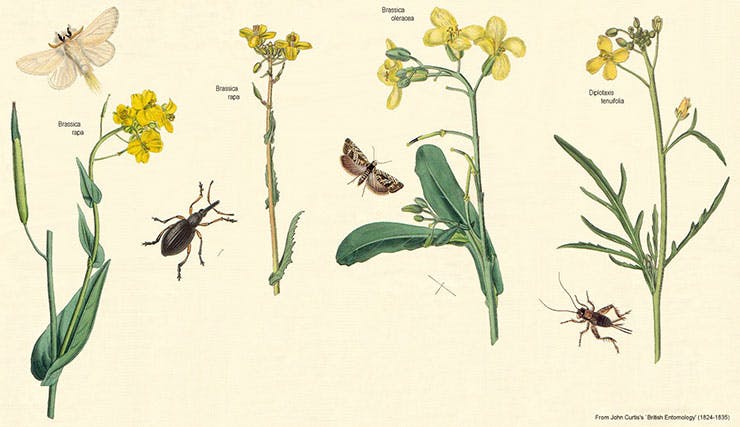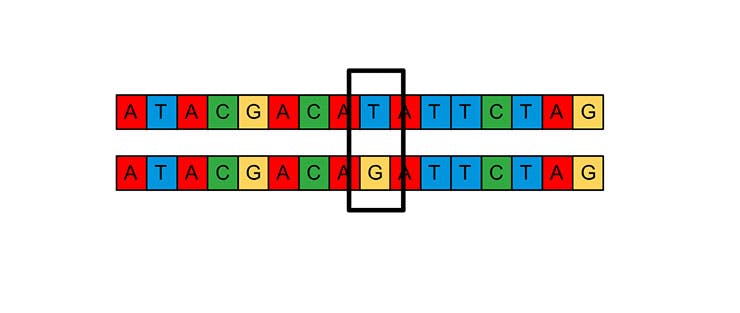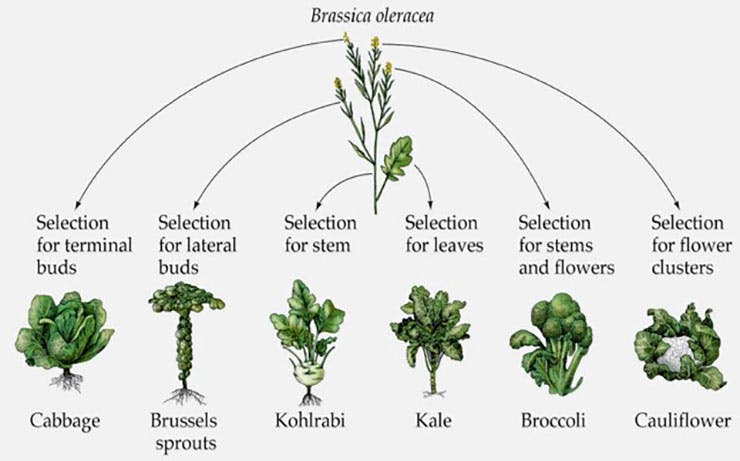Wild mustard can teach us a lot about plant potential

Botanical illustration of wild mustard (B. oleracea)
The word “evolution” has become ubiquitous and is now synonymous with adaptation and improvement. However, one core principle is frequently overlooked in popular culture: no single organism evolves. Only populationsof organisms evolve. The driving force behind evolution is natural selection or “survival of the fittest”—a phrase commonly attributed to Charles Darwin but borrowed from English philosopher Herbert Spencer.
When there’s variation in a population, individuals with favorable phenotypes for their environmental niche will survive longer and produce more offspring than others with less favorable phenotypes, increasing the frequency of their genetic variants (alleles). Shifting environmental conditions and a wide range of ecological niches tend to maintain variation in populations over time, while subpopulations become less diverse, maximizing favorable genetic combinations in their specific niche.

Genetic variation (aka allele) in a genome.
While humans are no exception to the forces of evolution and natural selection, they have managed to recognize the natural principles at play and exploit them for their own benefit. Darwin called this phenomenon artificial selection, which described the multitude of ways humans have manipulated other biological organisms via selection.
Plant breeding is one of the primary examples of the efficacy of artificial selection and is, at its core, human-directed evolution of plant populations. There are nearly endless examples of this practice throughout human history, but one extreme example is the case of a common weed, wild mustard. Cabbage, Brussels sprouts, kohlrabi, kale, broccoli and cauliflower were all selectively bred from a single plant species — Brassica oleracea (and that’s not the only species derived from wild mustard!).
Each B. oleracea subspecies we know today was selected upon to optimize production of various parts of the plant, from terminal and lateral buds to stems, leaves, flowers and roots. This species has thrived and diversified under artificial selection and shows that even if inherent genetic diversity exists within a species, recognizing the potential end-uses of a plant and vigorously selecting for those traits is what transforms them into highly useful crops that often don’t resemble the original population they were developed from.

Image via Vox
Given the genetic diversity of Cannabis sativa, discussed in Part 1, Part 2, and Part 3 of this series, breeders seeking to produce specific or unique qualities have a wealth of options. In addition, breeders have a mathematical formula to guide them in their quest for improved traits: The Breeder’s Equation.
Genetic gain — or trait improvement per generation, caused by selection on a genetically variable population — is the goal of breeding.

The Breeder’s Equation
This equation summarizes the basic factors that determine the pace of crop improvement; Practically, it means that the following can increase genetic gain:
- Large, diverse populations. Such populations contain a wide range of variable traits, allowing for the selection of only the highest performing plants while still maintaining access to critical genetic variation. Diversity, quality, and population size all have to be balanced with extreme care to maximize long-term genetic gain.
- Accurate and high-quality data. Higher data quality allows improved plants to be more efficiently identified and more stringently selected. Facility design, environmental controls, and standardized, objective phenotyping are critical factors to ensure that accurate phenotype data are captured. Phenotype data, along with high-resolution genetic data allows for powerful statistical selection procedures.
- Stringent selection. With a diverse population and high-quality data, selection is a powerful tool. The threshold for selection depends on many factors, including heritability of the trait(s) of interest and how those traits are influenced by environmental factors. The key to determining the right selection intensity is striking a balance of continued population improvement without causing severe genetic bottlenecks that may limit progress on improving other traits or breeding for different environments.
- Short generational cycles. Above all, breeding progress is limited by the length of time it takes to complete each biological cycle of hybridization, growth, and selection. Optimizing agronomic management approaches decreases cycle time, and utilizing genetic markers and predictive traits allows for selections to be made at the seedling/juvenile stage. These two strategies accelerate the breeding process by shortening cycle time and increasing the number of potentially superior plants being evaluated in each cycle, maximizing genetic gain per year.
Breeding the Perfect Variety
The “perfect” variety is completely subjective. Every breeder has a different concept of what their ideal plants look like and how they perform. There is plenty of overlap, where most people want quick-maturing, high-yielding plants, stuffed with cannabinoids and terpenes.
An important question to ask yourself is “what hasn’t been done yet?”
Looking to B. oleracea as an inspiration, we need to think critically about the untransformed potential of the plants we look at every day. As a community, we need to be predictive in our scope, thinking about how the cannabis market will change over the next 20 to 50 years and how we can build specialty plants to address the vast diversity of markets and end-uses. As individuals, we need to chart a path to achieve specific goals. The inherent genetic diversity of the species, which persists despite major bottlenecking events, is an opportunity to utilize artificial selection to make the species evolve in ways that most haven’t imagined.
Fortunately, there are well-established breeding methods and many genomic tools available to bridge the gap between the crop we currently work with to the next best thing. We can utilize these tools to create many “perfect” plants because there is no end to plant breeding. There is never a moment when a breeder says, “I’ve made the perfect plant so it’s time to quit”. Selection takes populations down a path, but it is never the only option.
The gene pool continues branching out, evolving, changing, and differentiating. Breeders are the stewards of these populations, charting out a path that maintains the health and diversity of genetic resources while making critical selections to create new and improved varieties. By identifying a personal ideal and making strategies to realize the potential of his or her plants, each breeder contributes to the evolution of the species.
About the author: Brian Campbell combines techniques from agronomy, plant breeding, population genetics and biotechnology to create improved cultivars. He’s a PhD candidate at Colorado State University where he studies functional and applied genetics of environmental adaptation in plants and how evolutionary forces have created adapted natural populations.
